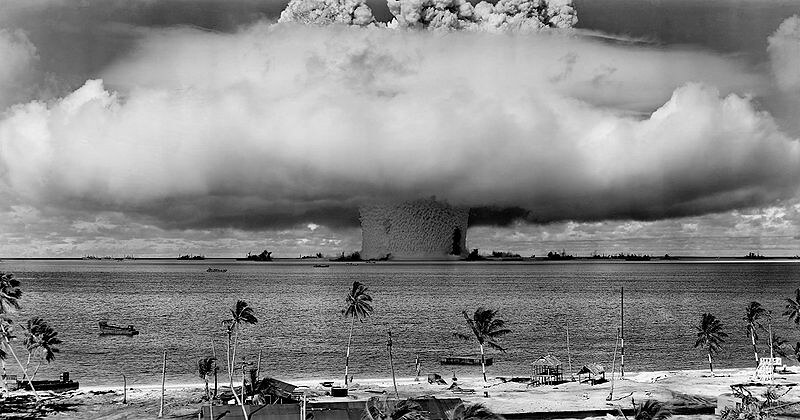The Atomic Bombing of Hiroshima and Nagasaki
In the final year of World War II in the Pacific the Allied forces led by the United States were preparing for a costly invasion of the Japanese mainland. This undertaking was preceded by a massive aerial bombing and firebombing campaign that devastated 64 Japanese cities.
The war in the Europe had ended in May 1945 with the German surrender but in the Pacific the Japanese , despite facing certain defeat, refused to capitulate .
By July the Allies’ Manhattan Project had produced two types of atomic bombs: “Fat Man”, a plutonium implosion-type nuclear weapon; and “Little Boy”, an enriched uranium gun-type fission weapon. These weapons were originally developed in part because of a fear that the Nazis in Germany were also developing a similar weapon.
A specialized version of the Boeing B-29 Superfortress, was deployed to Tinian in the Pacific Mariana Islands. The Allies had called for the unconditional surrender of the Imperial Japanese armed forces in the Potsdam Declaration in July 1945, the alternative being “prompt and utter destruction”. The Japanese government ignored the ultimatum.
Orders were issued on 25 July by the acting chief of staff of the United States Army, for atomic bombs to be used against the cities of Hiroshima, Kokura, Niigata, and Nagasaki. These targets were chosen because they were large urban areas that also held militarily significant facilities.
On 6 and 9 August 1945, the United States detonated two atomic bombs over the Japanese cities of Hiroshima and Nagasaki, respectively. The aerial bombings together killed between 129,000 and 226,000 people, most of whom were civilians, and remain the only use of nuclear weapons in an armed conflict.
After Hiroshima, Japanese Prime Minister Kantarō Suzuki reiterated the Japanese government’s commitment to ignore the Allies’ demands and fight on. So three days later, a Fat Man was dropped on Nagasaki.
Following the second bomb, Japan surrendered to the Allies on 15 August, six days later .
The Japanese government then signed the instrument of surrenderon 2 September, effectively ending the war
If Japan had not surrendered , the US had another “Fat Man” atomic bomb ready for use on 19 August, with three more in September and a further three in October;a second Little Boy bomb (using U-235) would not be available until December 1945.
Over the next two to four months, the effects of the atomic bombings killed between 90,000 and 146,000 people in Hiroshima and 60,000 and 80,000 people in Nagasaki; roughly half occurred on the first day.
For months afterward, many people continued to die from the effects of burns, radiation sickness, and injuries, compounded by illness and malnutrition. Though Hiroshima had a sizable military garrison, most of the dead were civilians.
Scholars have extensively studied the effects of the bombings on the social and political character of subsequent world history and popular culture, and there is still much debate concerning the ethical and legal justification for the bombings. Supporters claim that the atomic bombings were necessary to bring an end to the war with minimal American casualties; critics believe that the bombings were unnecessary for the war’s end and a war crime, and highlight the moral and ethical implications of the intentional nuclear attack on civilians.
The uranium bomb detonated over Hiroshima had an explosive yield equal to 15,000 tonnes of TNT. It razed and burnt around 70 per cent of all buildings and caused an estimated 140,000 deaths by the end of 1945, along with increased rates of cancer and chronic disease among the survivors.
A slightly larger plutonium bomb exploded over Nagasaki three days later levelled 6.7 sq km. of the city and killed 74,000 people by the end of 1945. Ground temperatures reached 4,000°C and radioactive rain poured down.
If a nuclear weapon were to be detonated over a city today, first responders – hospitals, firemen, aid organisations – would simply be unable to help.
It takes around 10 seconds for the fireball from a nuclear explosion to reach its maximum size, but the effects last for decades and span across generations.
Five to six years after the bombings, the incidence of leukaemia increased noticeably among survivors. After about a decade, survivors began suffering from thyroid, breast, lung and other cancers at higher than normal rates.




